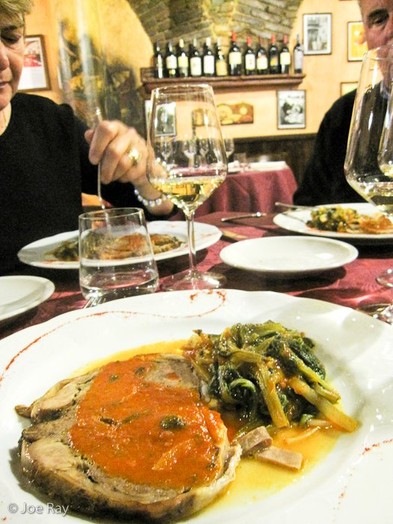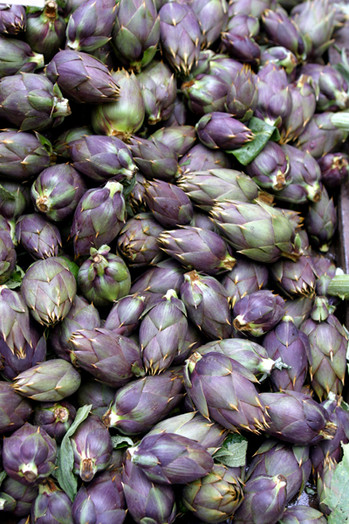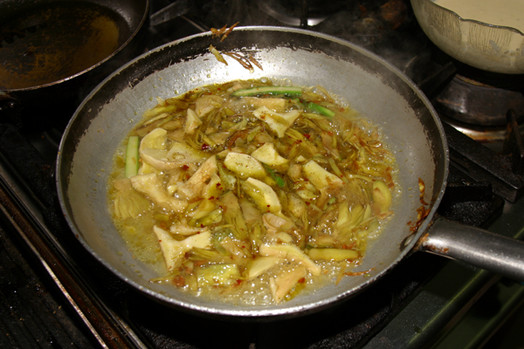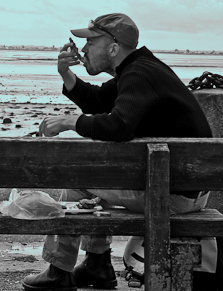Joe Ray
Food & Travel / Words & Photos

Thursday, May 21, 2009
Mom, The Fox and The Jew’s Harp
CASTELBUONO, SICILY
PRELUDE
Driving through Sicily, Mom asks if there are many foxes roaming the island – a question completely out of left field, and as likely a subject as if she had a sudden interest in stock quotes.
FOOD
Dinner at Nangalarruni in Castelbuono is a snapshot of Sicilian cuisine. A starter salad of blood oranges and pearl onions is served with thin slices of tobacco-smoked pork, sprinkled with salt flakes and dappled with olive oil and deeply-flavored musto cotto from 1987. The dish shows a native love for sweet and savory, reverence for history and an inventive playfulness. Much of that can also be seen in the following course - a bread pie served next to a big, comma-shaped swirl of ricotta cream.
It’s at this point in the meal where chef Peppino Carollo, who I’ve blogged and written about, sits down one table away to have dinner with his brother on a quiet Monday night. Staying undercover would have been nearly impossible, not to mention really awkward. Besides, it’s hard to braise a wild boar shank (our next course) in 10 minutes.
Instead, we talk. The brother is in town from Rome to hunt mushrooms with Chef in the hills above town – Nangalarruni may mean ‘jew’s harp’ but the restaurant is a mushroom-lover’s heaven and the walls here are covered with paintings of fungi and pictures of Chef and friends after successful mushroom hunts.
Who’s manning the kitchen while chef is having dinner with his brother?
“He’s young,†Chef says of sous-chef Giandomenico Lammonica, but it’s not hard to understand why he is Carollo’s right-hand man – Lammonica has a mushroom farm above town that he tends to as a hobby.
A several-course tasting meal at Nangalarruni is a bargain at 30 euros and the great wine list has gentle prices, perhaps owing a bit to Chef’s wife running two small wine shops in town.
FULL CIRCLE
Walking back after a late-night stroll through town, a fox appears in front of our door.
…
When in Castelbuono, stay at the Casa Ilaria B&B. It’s hidden, quiet, beautiful, spacious and run by gracious owners. It’s also a steal at 30 euros per person per night.
Nangalarruni MAP
Via delle Confraternite, 5/7
Castelbuono
+39 0921 671428
www.hostarianangalarruni.it
Casa Ilaria
Piazza Tenente Schicchi, 5
Castelbuono
+39 0921 676268
http://www.casailaria.it/


Tuesday, April 24, 2007
Winking At The Matriarch
A calm chef is a rare bird, usually signifying that his restaurant is about to fold or that he’s depressed. In Peppino Carollo’s case, however, his calm comes from successfully crossing a bridge from traditional Sicilian cuisine to something that is his own.
“I don’t like making carbonara. Pannacotta? I can’t do it,” he said referring to heavy Italian classics.
Here in Sicily, tradition often comes from harder times like making it through a famine or feeding a town surrounded by an attacking enemy.
Today, matriarchs have it easier but still need to fill the bellies of their ilk at seemingly endless Sunday meals and restaurant food here can be heavy enough that you understand why things like vomitoriums used to be installed around the island.
While Carollo’s cooking is clearly Sicilian, a meal at his Castelbuono restaurant, Nangalarruni, leaves you with that healthy, end-of-a-sushi-meal feeling.
“It makes me happy to create new sensations,” he said. “I like to let the old recipes remind me of the past…I think of grandma when I cook, but I do my own stuff.”
Right now, this means concentrating on artichokes.
For Carollo, the keys are three closely tied concepts: seasonality, simplicity and perfect products. There’s also the pleasantly curious addition of economy.
“In November (when they are hard to get), an artichoke costs one euro (about $1.30). Now, they’re cheap. This is the time to get them,” he said, helping to explain why his highly-respected establishment is also known as a bargain.
He demonstrated this with three plates highlighting artichokes – a carpaccio with cheese and oranges, a batter-dipped classic called carciofi in pastella and in a veggie sauce to accompany fresh tagliatelle. None of these dishes took more than 15 minutes to prepare.
For the tagliatelle, he put a large saucepan over medium-high flame, poured a thick coat of olive oil onto the bottom and added two peeled garlic cloves that he had lightly crushed with his hand. He cut the tops off of a couple of artichokes, pinched off several outer layers of leaves, halved them lengthwise and cored with a pen knife called a Siciliano. He sliced the halves into skinny strips and tossed them in the pan, giving it a flip or two that painted them the rich green of the olive oil. While that cooked, he peeled and halved a couple asparagus tips, added those, then sliced a few handfuls of local mushrooms and tossed them on top.
“They are all ingredients that only need a little cooking time.” he said. “You want to feel their al dente – their crunch.”
He removed the garlic, added a few small ladles of a light vegetable broth, along with some salt, pepper and red pepper flakes and let the whole thing bubble away while he tossed the fresh tagliatelle into boiling water.
“The tagliatelle gets one minute to cook. Just one,” he said, gently brushing me out of the way before he pulled it out and added it to the saucepan with the vegetable sauce.
“It’s very quick cooking, very healthy… buono,” he said plating the pasta and making that ‘lips kissing fingertips’ gesture before adding a few sprigs of wild fennel and a final drizzle of olive oil, over the top, the warmth of the dish releasing the aroma of the final additions.
Looking like he spent a lot of time watching his grandmothers cook as he grew up, there’s also an impressive practicality to the way he cooks. He holds the artichokes by the stem as he dips them into a batter before frying to reduce mess, he smells the olive oil every time he uses it and the closest thing he seems to have to measuring cups are his hands.
Though he’s clearly pushing things in a new direction, his pastella turns out to be almost identical to one I had prepared by a grandmother at a family dinner the day before.
“We don’t do a lot of fried stuff,” he said, but hunched his shoulders as if to say that this was one part of tradition that was best left untouched.
This is Joe Ray reporting from the Motherland.
